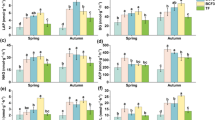Summary
Phosphate fertilizer incorporated in the soil placed around tea plants when planted in the field produced a large improvement in the rate of growth of the plants, thus indicating that tea in acid soils had a demand for phosphate. Yield responses to phosphate fertilizer applied to mature tea were uncommon and the pattern of these confused. This work showed that mature tea will absorb phosphate and give positive yield responses when there is an undisturbed mulch layer on the soil surface. Within this layer phosphate is maintained in a more available form and many highly active roots are formed. These conditions are destroyed by manual weeding; the mulch forms naturally from tea leaves and prunings where no-cultivation herbicidal weed control is practised.
Similar content being viewed by others
References
Ali, M. M., Agro-Botany Division. Research. Ann. Rep. Pakistan Tea Res. Stn. Research Sta.1966, 28–32 (1968).
Cooper, H. R., Nitrogen utilisation in tea. Indian Tea Association, Memorandum No.6, 141, 165–179 (1966).
De Haan, I., Bemesting met kali en fosforzuur van een theeanplant op sterk verweerde laterietgrond. Arch. Theecult.16, 53–69 (1948).
Hainsworth, E., Private communication.
Hu, C. C. and Yu, C. F., A report on plant food requirements of the tea bush. Bulleting of Pinchen Tea Experimental Station, No.4 (1953).
Jourbitsky, S. I. and Strausberg, D. V., Foliar diagnosis of the tea plant nitrogen and potassium. Fertilite26, 3–6 (1966).
Le Mare, P. H., Effects of phosphate applied to a Buganda soil. J. Agr. Sci. Cambridge70, 285 (1968).
Lin, C. F., Plant testing (4): leaf analysis as a guide to nitrogen fertilisation of tea bushes (2). Bulletin of Pinchen Tea Experimental Station. No.35. (1966).
Lin, C. F., Plant testing (5): leaf analysis as an aid in the NPK-fertilisation of tea bushes. Bulletin of Pinchen Tea Experimental Station. No.40 (1967).
Lindsay, W. L. and Stephenson, H. F., Nature of the reactions of monocalcium phosphate monohydrate in soils: 1. The solution that reacts with the soil. Soil Sci. Soc. Am. Proc.23, 12–18 (1959).
Ondani, O. G., Determination of indices of phosphorus and potassium content in crops on tea and citrus plantations. Subtrop. Kultur'y2, 127–135 (1969).
Pritula, Z. V., Examination of mineral feed used for tea-plants in the Krasnodar regional conditions. Izv. timirjazev sel'hoz Akad.,4, 129–136 (1966).
Raman, K. H., Foliar application of phosphatic fertiliser. Annual Report of the Tea Scientific Department, United Planters' Association of South India1964–5, 33 (1965).
O'Shea, P. B. T., Maxwell, D, and Brandram-Jones, R. E., Agronomic Investigations. Rep. Tea Research Inst. East Africa1963, 53–68 (1964.
Robinson, J. B. D. and Hosegood, P. H., Effects of organic mulch on fertility of a latosolic coffee soil in Kenya. Expl. Agr.1, 67–80 (1965).
Rovira, A. D. and Bowen, G. D., Anion uptake by plant roots: distribution of anions and effects of micro-organisms. Trans. 9th Int. Conf. Soil Science, Adelaide, 209–217 (1968).
Sharma, K. N. and Barua, S. C., Agriculture Department. Research and Experiments. NPK manuring. Mature tea. Rep. Tocklai Exp. Sta.1966, 48–52 (1967).
Shaxson, T. F., Fertilizer experiments. Ann. Rep. Tea Association Central Africa1964–5, 17–30 (1966).
Smith, A. N., The effect of fertilisers, sulphur and mulch on East African Tea Soils. 1- The effect on the pH reaction of the soil. East African Agr. For. J.27, 158 (1962).
The use of fertilisers on established tea. Phosphate. Tea Research Institute of East Africa. Tea Estate Practice1966, 49 (1966).
Tolhurst, J. A. H., Concluding report on a phosphate manurial trial. Tea Quarterly34, 144–147 (1963).
Tolhurst, J. A. H., Report of the Agricultural Chemistry Division. Tea Research Inst. Ceylon Ann. Rep.1966, Part 2, 24–25 (1967).
Vink, A. P. A., Proeven en problemen met betrekking tot bemesting en schaduw in de theecultuur. Arch. Theecult.18, 33–89 (1954).
Wu, C. T., A report on the tea soils and the nutrient requirement of tea in Taiwan. Bull. Pinchen Tea Exp. Sta. No.5 (1957).
Author information
Authors and Affiliations
Rights and permissions
About this article
Cite this article
Willson, K.C., Hainsworth, E., Green, M.J. et al. Studies on the mineral nutrition of tea. Plant Soil 43, 259–278 (1975). https://doi.org/10.1007/BF01928491
Received:
Issue Date:
DOI: https://doi.org/10.1007/BF01928491




